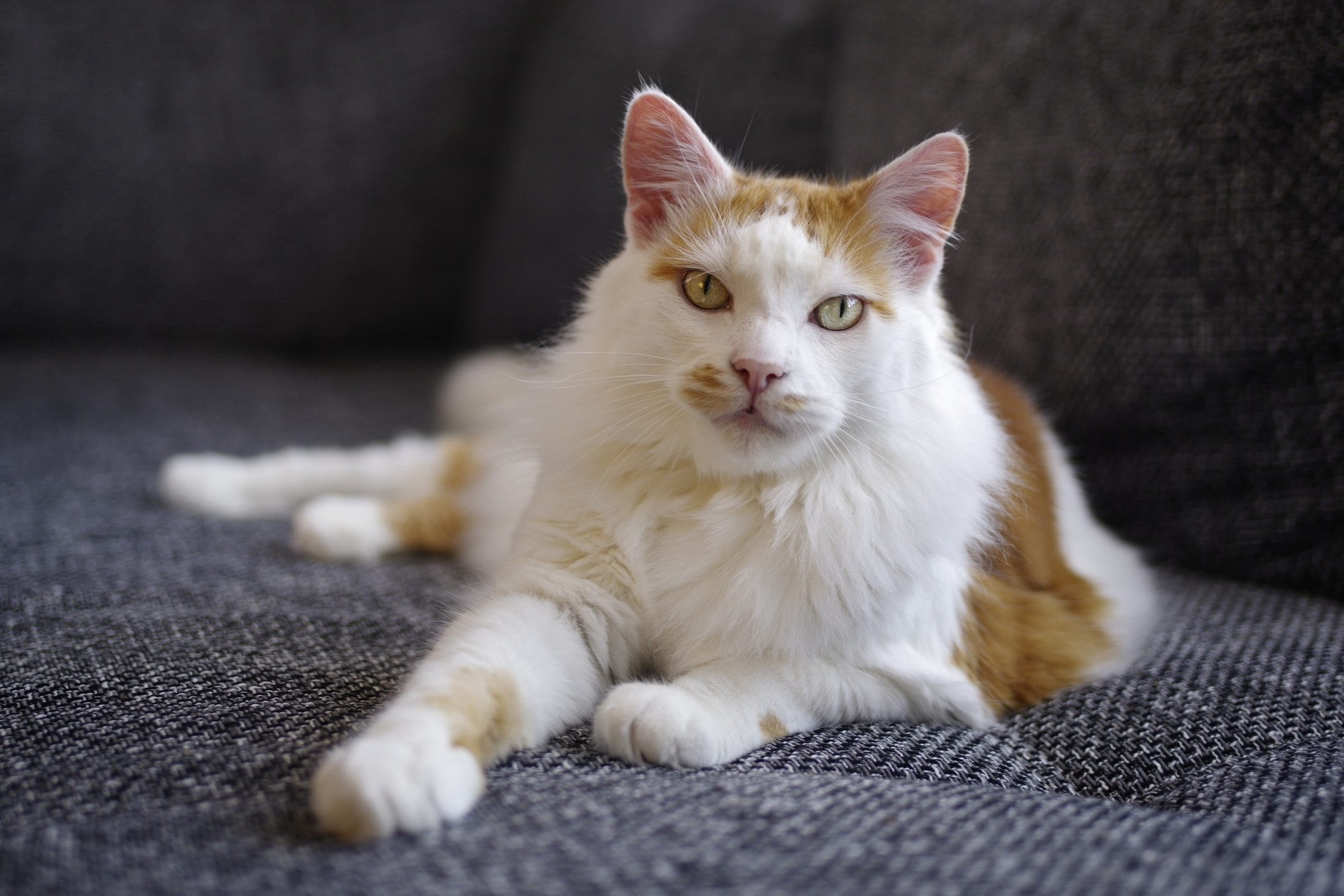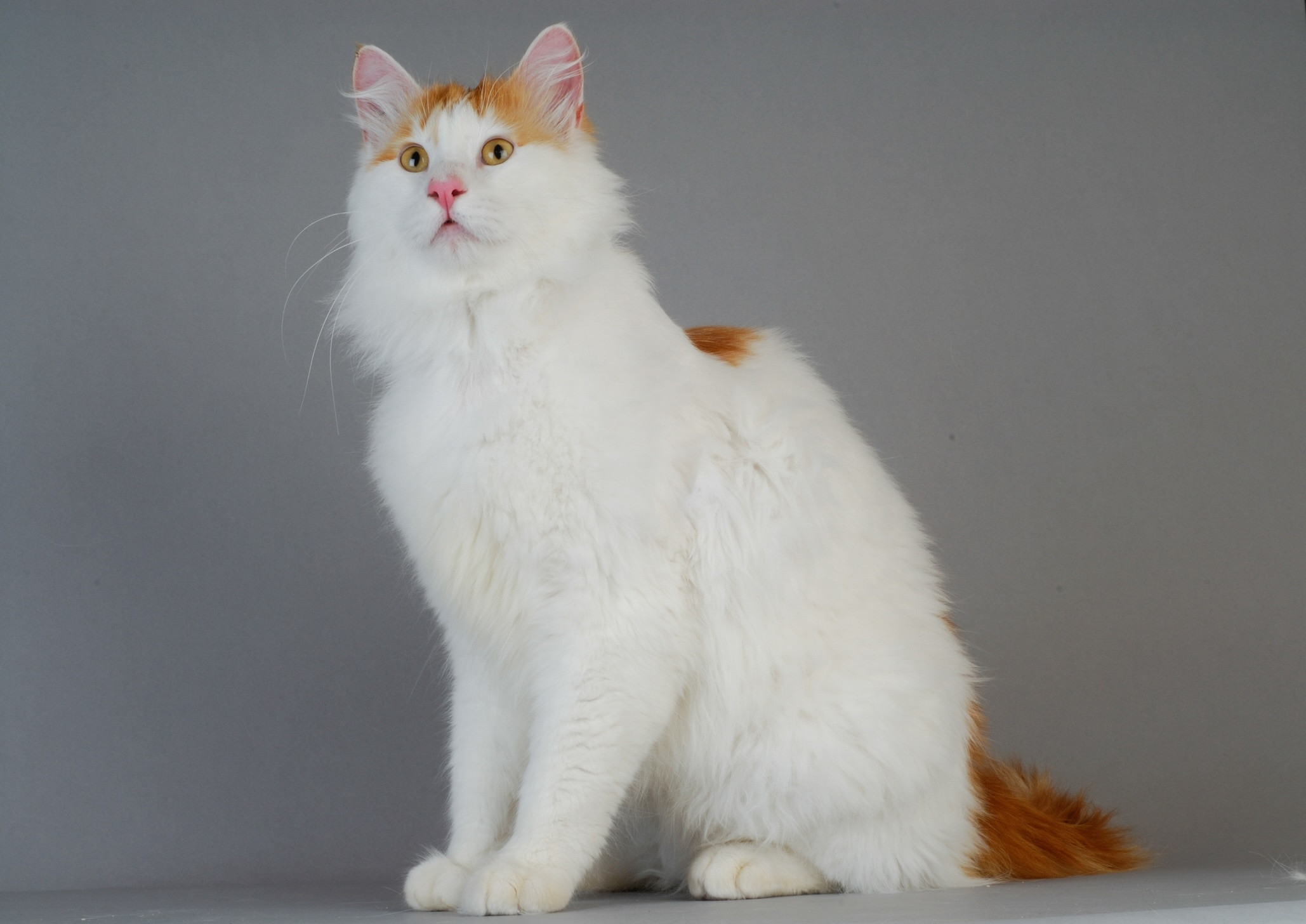The Turkish Van cat is a captivating breed that shatters typical feline stereotypes. Originating from the Lake Van region of Turkey, this naturally occurring breed is affectionately known as the “swimming cat” due to its unusual affinity for water. Beyond their aquatic inclinations, Turkish Vans possess a distinctive personality and striking appearance that sets them apart in the feline world. Often described as having dog-like qualities, these intelligent and active cats can even be trained to perform tricks like fetching.
Reaching a height of 10 to 14 inches and weighing up to 20 pounds, the Turkish Van is a substantial cat with a semi-longhaired coat that is luxuriously soft to the touch.
Caring for Your Turkish Van: Embracing Their Active Nature
Turkish Vans are bundles of energy, renowned for their playful and inquisitive nature. They are not your typical lap cats content to lounge around all day. These felines thrive on activity, relishing in games, climbing, and exploring their surroundings. To prevent them from turning your countertops and furniture into their personal playground, it’s crucial to provide ample outlets for their energetic spirits. Investing in cat trees, scratching posts, and wall-mounted shelves will create a stimulating vertical environment, satisfying their natural urge to climb and explore.
And don’t be surprised if you catch your Turkish Van engaging in some aquatic antics. Unlike many cats that avoid water at all costs, Turkish Vans are often drawn to it. You might find them playfully splashing in their water dish or even attempting to join you for a dip in the bathtub. This fascination with water is a defining trait that makes them truly unique.
While many cat breeds can exhibit white coats, the Turkish Van is particularly celebrated for its striking white fur and the distinctive “Van” pattern. This pattern, named after the breed itself, is characterized by a predominantly white body with color restricted to the head and tail. This unique coloration, combined with their muscular build, gives them an elegant and eye-catching appearance.
The Turkish Van’s coat is not only visually appealing but also possesses a remarkable seasonal adaptability. In the colder winter months, they develop a thick, luxurious coat, complete with a prominent chest ruff and even fur between their toes, providing insulation against the elements. As the weather warms, they shed this heavy winter coat, transitioning to a shorter, lighter summer coat.
This seasonal coat change means Turkish Vans experience periods of significant shedding, particularly during the spring and fall. However, due to the lack of a dense undercoat, their fur is less prone to matting compared to many other longhaired cat breeds. This makes grooming relatively manageable, requiring less frequent brushing to keep their coat in good condition.
Understanding Turkish Van Health: A Naturally Robust Breed
 Turkish Van cat with distinctive Van pattern lounging indoorsPhoto by Lightspruch/iStock / Getty Images Plus via Getty Images
Turkish Van cat with distinctive Van pattern lounging indoorsPhoto by Lightspruch/iStock / Getty Images Plus via Getty Images
The Turkish Van stands out as one of the few natural cat breeds, meaning their development was shaped by natural selection over time, rather than human-directed selective breeding. This natural evolution has bestowed upon them a degree of genetic robustness, making them generally less susceptible to certain hereditary health issues that can arise from selective breeding practices.
A notable example of this natural resilience is their hearing. While a significant percentage of white cats with blue eyes are prone to deafness, Turkish Vans, even those with white fur and blue eyes, are typically not predisposed to hereditary deafness. This contrasts with the Turkish Angora, a similar-looking natural breed, which can be more prone to this condition.
Despite their generally robust health, routine veterinary checkups remain crucial for preventive care. Like all cats, Turkish Vans can still develop common feline illnesses. Regular visits to the veterinarian ensure early detection and management of any potential health concerns, contributing to a long and healthy life for your Turkish Van.
Dental Disease: A Common Feline Concern
Dental disease is a prevalent health issue affecting a large proportion of cats. Studies indicate that a significant majority of cats over the age of four exhibit some form of dental disease.
Proactive dental care is essential to prevent oral health problems in Turkish Vans. Regular teeth brushing using cat-safe toothpaste is highly recommended. In addition, routine veterinary dental checkups and professional cleanings are vital for maintaining their oral hygiene and preventing the development of dental disease. Untreated dental problems can cause pain, bad breath, and even systemic health issues in cats.
Obesity: Maintaining a Healthy Weight
Obesity is another widespread health concern in the feline population, with a considerable percentage of cats being overweight or obese.
To help your Turkish Van maintain a healthy weight, ensuring daily interactive playtime is crucial for exercise. Careful portion control during mealtimes is equally important, and limiting treats to a small percentage of their daily caloric intake will prevent excess weight gain.
Consulting with your veterinarian is advisable to determine the ideal weight for your Turkish Van. If necessary, your vet can help create a tailored weight management plan to ensure your feline companion stays fit and healthy.
Nutritional Needs of a Turkish Van: Fueling Their Active Lifestyle
Turkish Vans thrive on a diet of high-quality, nutritionally balanced cat food. When choosing cat food, prioritize commercial diets that include a nutritional adequacy statement from the Association of American Feed Control Officials (AAFCO). This statement guarantees that the food meets the comprehensive nutritional requirements for cats.
Select cat food formulations that are appropriate for your Turkish Van’s life stage, whether they are a kitten, adult, or senior cat. Each stage of life has distinct nutritional needs that are best met with age-specific formulas.
Feeding Guidelines for Turkish Vans
It is generally recommended to feed cats, including Turkish Vans, several small meals throughout the day, ideally two or more. You can opt for wet food, dry food, or a combination of both, catering to your cat’s preferences and nutritional needs.
Avoid free-feeding your Turkish Van, as this practice can contribute to overeating and subsequent weight gain. Scheduled mealtimes help regulate their food intake and maintain a healthy weight.
Determining Portion Sizes for Your Turkish Van
Knowing precisely how much to feed your cat can be challenging. Your veterinarian is an invaluable resource in this regard. They can assess your Turkish Van’s individual needs based on their weight, activity level, and age, and provide personalized feeding recommendations.
AAFCO-compliant cat food packaging typically includes feeding guidelines based on your cat’s weight, which can serve as a starting point in determining appropriate portion sizes.
Supplementation for Turkish Vans: When is it Necessary?
Turkish Vans fed a high-quality, balanced cat food generally do not require additional supplements. However, as cats age or if they develop specific health conditions, your veterinarian may recommend certain supplements on a case-by-case basis to address specific nutritional deficiencies or health needs.
Always consult with your veterinarian before introducing any supplements to your Turkish Van’s diet. Unnecessary supplementation can sometimes be detrimental to their health.
Turkish Van Behavior and Training: Embracing their Dog-like Traits
 Playful Turkish Van cat with orange and white markings looking alertPhoto by Michel VIARD/iStock / Getty Images Plus via Getty Images
Playful Turkish Van cat with orange and white markings looking alertPhoto by Michel VIARD/iStock / Getty Images Plus via Getty Images
While individual cat personalities vary, the Turkish Van temperament is often characterized as playful, sociable, and remarkably friendly. They are known for forming strong bonds with their families and enjoying interaction.
Early socialization is crucial for Turkish Van kittens to ensure they develop into well-adjusted adults comfortable with a variety of people, animals, and environments. Exposing them to dogs, new people, and other cats from a young age, in a gradual and positive manner, will help them become confident and social companions. Remember to always introduce new pets and people to your Turkish Van slowly and patiently.
Turkish Vans are known for their affection and love of company, but they are not always “lap cats” in the traditional sense. While they enjoy being near their people, they may not always be inclined to cuddle for extended periods. It’s important to respect their individual boundaries and teach children to do the same, ensuring positive interactions and a comfortable environment for your Turkish Van.
One of the most distinctive behavioral traits of Turkish Vans is their affinity for water. Unlike many cats who instinctively avoid water, Turkish Vans may actively seek it out. Providing a cat water fountain can be both a source of hydration and entertainment for these water-loving felines.
Turkish Vans are also intelligent and athletic cats. Without sufficient outlets for their energy and natural instincts, they may exhibit unwanted behaviors such as scratching furniture, excessive meowing, or climbing on countertops. Providing appropriate scratching posts, climbing structures, and interactive toys is key to channeling their energy constructively.
Turkish Vans are surprisingly trainable, often displaying dog-like trainability. They can learn a variety of commands and tricks, from fetching toys to coming when called, and even walking on a harness and leash. Positive reinforcement techniques, using praise and cat treats as rewards, are highly effective in training Turkish Vans. Keep training sessions short, fun, and engaging to maintain their interest and motivation.
Fun Activities to Engage Your Turkish Van:
- Playing fetch with toys
- Basking in the sun on a window perch
- Exploring the outdoors on a harness and leash
- Birdwatching from a secure catio
- Engaging with puzzle toys that challenge their intelligence
Turkish Van Grooming: Maintaining Their Luxurious Coat
Turkish Vans are relatively low-maintenance in terms of grooming, making them a convenient breed for busy pet owners.
Skin Care Considerations for Turkish Vans
Light-colored cats, like Turkish Vans with predominantly white coats, are more susceptible to sunburn, particularly in areas with less fur coverage such as the nose and ear tips. While restricting their sun exposure entirely may be impractical, consider applying UV-blocking film to windows to provide an extra layer of sun protection indoors.
Coat Care for a Healthy Sheen
Turkish Vans are moderate shedders for most of the year, and their single coat, lacking a dense undercoat, is less prone to matting. The cashmere-like texture of their fur further contributes to its manageability.
However, during seasonal transitions, particularly from winter to summer, Turkish Vans experience a more significant shedding period as they shed their thicker winter coat. During these periods, brushing a few times a week will help manage loose fur. For the rest of the year, a simple weekly brushing is typically sufficient to keep their coat healthy and free of tangles.
Eye Care for Bright Eyes
Turkish Vans can have striking eye colors, including blue, green, or yellow. Some individuals may even exhibit heterochromia, having eyes of two different colors.
Regularly monitor your Turkish Van’s eyes for any changes, such as redness or discharge. If you observe any abnormalities, consult your veterinarian promptly, as these could be signs of an eye problem requiring attention.
Ear Care for Healthy Hearing
Head shaking, excessive ear scratching, and discharge from the ears are potential indicators of an ear infection in cats. If you notice any of these symptoms in your Turkish Van, it’s essential to seek veterinary care to diagnose and treat any ear issues.
Considerations for Prospective Turkish Van Owners
The Turkish Van is a captivating and intelligent breed known for its playful nature and unique love of water. To cater to their active lifestyle, provide them with cat trees, scratching posts, and wall shelves to create a stimulating vertical environment. Even a cat water fountain can serve as a source of enrichment and entertainment.
Turkish Vans are generally a healthy breed with limited known genetic predispositions to health problems. However, routine veterinary checkups are essential for preventative care and maintaining their well-being. Regular at-home grooming practices, including nail trims, teeth brushing, and coat brushing, contribute to their overall health and hygiene between vet visits.
Turkish Vans make wonderful companions for cat enthusiasts who appreciate an intelligent, playful, and distinctive feline that defies typical cat stereotypes. They are a breed that brings a unique blend of energy, affection, and aquatic charm to the homes they share.
Turkish Van FAQs
Is a Turkish Van a rare cat breed?
Yes, Turkish Vans are considered a relatively rare cat breed. As a natural breed, their development occurred without extensive human intervention, contributing to their limited numbers compared to selectively bred breeds. This rarity can also influence Turkish Van cat prices, often making them more expensive.
Are Turkish Van cats known for being cuddly?
While Turkish Vans are affectionate and enjoy being around their families, they are not typically known as lap cats that constantly seek cuddling. They are more independent in their displays of affection but still form strong bonds with their human companions.
How to identify a Turkish Van cat?
Turkish Vans possess a distinctive coat pattern and seasonal coat changes that aid in identification. Their coat is predominantly white with colored markings (red, brown, or black) primarily on the head and tail, known as the “Van pattern”. They have a semi-long coat in the winter, which becomes shorter in the summer, adapting to the changing seasons. This combination of coat pattern and texture is a key characteristic of the Turkish Van breed.

